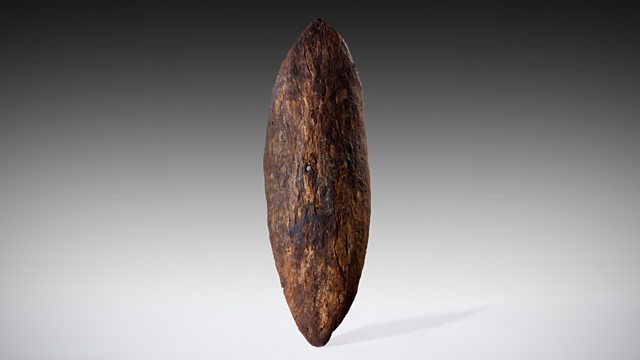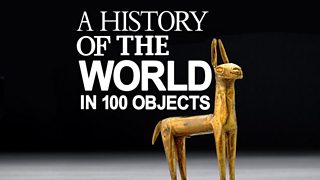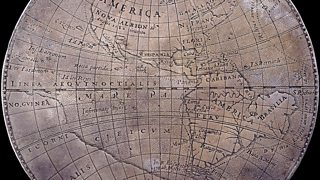Australian Bark Shield
Neil MacGregor is looking at Europe's engagement with the rest of the world during the 18th century. Today, a bark shield brought from Australia by Captain Cook.
The history of humanity as told through one hundred objects from the British Museum in London. This week, Neil MacGregor, the Director of the Museum, is looking at Europe's engagement with the rest of the world during the 18th century.
Today he is with an object "freighted with layers of history, legend, global politics and race relations". It is a shield from Australia, originally owned by one of the men to first set eyes on Europeans as they descended on Botany Bay nearly 250 years ago. This remarkably well-preserved object was brought to England by the explorer Captain Cook. What can this object tell us about the early encounter between two such different cultures? Phil Gordon, the aboriginal Heritage Officer at the Australian Museum in Sydney, and the historian Maria Nugent help tell the story.
Producer: Anthony Denselow
Last on
![]()
A History of the World in 100 Objects - objects related to money, trade and travel.
About this object
Location: Botany Bay, Australia
Culture: Native North America
Period: 1770
Material: Wood
��
This bark shield was carried by one of two Indigenous Australian men who faced Captain Cook and his crew members when they first landed at Botany Bay, near Sydney on the 29 April 1770. After attempts to communicate with the men failed, Cook's crew fired warning shots. This shield was dropped when the Indigenous Australians fed. The hole in the centre of the shield was probably made by a wooden spear and there are also traces of white clay decoration on the surface.
What was the significance of Cook's landing at Botany Bay?
Cook was not the first European to visit Australia or meet Indigenous Australians. Cook's encounter is seen by many as the beginning of European Australia. Cook went on to claim Australia for the British Empire in August 1770. The first European settlers, prison convicts, arrived at Botany Bay in 1788. This began the European colonisation of Australia, which led to an estimated 90 per cent reduction in the Indigenous Australian population.
Did you know?
- Humans first arrived in Australia about 50,000 years ago, when you could walk from Australia to New Guinea and Tasmania.
How did the hole get there?
By Caroline Cartwright and Janet Ambers, scientists, British Museum
��
The wood of this shield has been identified as spotted mangrove, sometimes called red mangrove. It is a straight-growing and strong wood, very resistant to insect attack and rot, even when covered by seawater.
The choice of mangrove wood for making shields is a very sensible one as this wood has the properties of either absorbing the impact of a spear, a musket ball or deflecting a club or other weapon. So, the hole in the shield has stimulated much interest and discussion.
Various suggestions have been put forward including whether it was caused by a musket ball, or accidental damage at some point in the shield’s history, or where a knot in the wood fell out, or perhaps the handiwork of a giant woodworm!
In the British Museum’s scientific laboratory we examined the hole very closely under the optical microscope and by radiography. One possible line of investigation was to establish whether it might be the result of an attempt to make a hole for the grip on the rear which failed or was misaligned. The present grip was made from a separate piece of flexible, fresh mangrove branch which had been bent and inserted very tightly into two holes bored in the shield's mid-section. When the wood dried the embedded grip was very firmly attached.
Examination by microscopy and radiography confirmed that the hole is very ragged, unlike a deliberately-bored or intentional, tool-made perforation. If the hole had been intentionally created, it would most likely be hourglass-shaped (if bored from both front and back to meet in the middle) or straight- and smooth-sided (if bored directly through from front or back). So it seems as though intentional perforation can be ruled out.
It is possible that it represents an area where a knot fell out. Knots in wood represent branches or branchlets emerging at right angles or obliquely and even though they can fall out, the holes they leave are most likely to be oval or circular with regular, smooth sides.
This hole appears very irregular and ragged, matching more closely with comparative examples of impact or damage points, with some parts of the hole appearing to have more recent fractures or detachments than others.
Without further experimentation or replication one cannot state conclusively whether this particular hole was caused by a spear or a musket ball (or later accidental damage) but it is possible.
Finally – it is important to consider molluscs! There are certain gastropods and bivalves that have been recorded as boring into the wood of various mangrove species, particularly the bivalve Teredo sp. (the so-called ‘mangrove worm’). This worm is known to dig holes in mangrove wood. But wood that has been attacked by such wood-borers rarely results in just one hole.
So, the answer is… we can’t be sure!
Mapping for trade, commerce and empire
By Professor Nicholas Thomas, fellow, Trinity College, University of Cambridge
��
Cook began his career as an ordinary seaman in the navy, but gained great renown as a surveyor in Canadian waters in the war of 1758-63.
When the Royal Society lobbied the King for support for a mission to the Pacific to observe the transit of Venus Cook was a natural choice. He’d demonstrated his abilities as a surveyor during the Canadian war of 1758-63 and he was clearly a remarkably skilled navigator and map maker. When he went to the pacific the ostensible object was the observation of the transit of Venus, but the real question, the real question that had preoccupied the minds of geographers, traders, many in Europe for centuries, was whether a Great Southern Land existed.
So, during the first voyage he charted the East Australian coast, circumnavigated the islands of New Zealand, and demonstrated an extraordinary ability as a cartographer.
On his return to England in 1771 he laid out a plan that would establish once and for all whether a Southern Continent existed. That plan involved criss-crossing the Antarctic waters in increasingly remote southern latitudes. It would test the question of whether a great land, that might be significant for European trade, commerce and colonisation, actually existed or not.
The voyage was undertaken in an extraordinarily methodical way. There was no Southern Land but what he did find was an extraordinary range of islands and populations in the Pacific that surprised Europeans in all sorts of ways.
Cook was brilliant in a technical sense as a surveyor, a navigator, a cartographer. And that form of knowledge – those new knowledges – were enormously significant ion the late eighteenth century in a climate where all sorts of new technical knowledges, new forms of research were being refined and extended. But of course those forms of knowledge were sought because of their huge potential significance: trade, commerce, and empire.
Transcript
Broadcasts
- Thu 7 Oct 2010 09:45�鶹������ҳ��� Radio 4 FM
- Thu 7 Oct 2010 19:45�鶹������ҳ��� Radio 4
- Fri 8 Oct 2010 00:30�鶹������ҳ��� Radio 4
- Thu 16 Sep 2021 13:45�鶹������ҳ��� Radio 4
Featured in...
![]()
Money, Trade and Travel—A History of the World in 100 Objects
A History of the World in 100 Objects - objects related to money, trade and travel.
![]()
War—A History of the World in 100 Objects
A History of the World in 100 Objects - objects related to war.
Podcast
-
![]()
A History of the World in 100 Objects
Director of the British Museum, Neil MacGregor, retells humanity's history through objects





